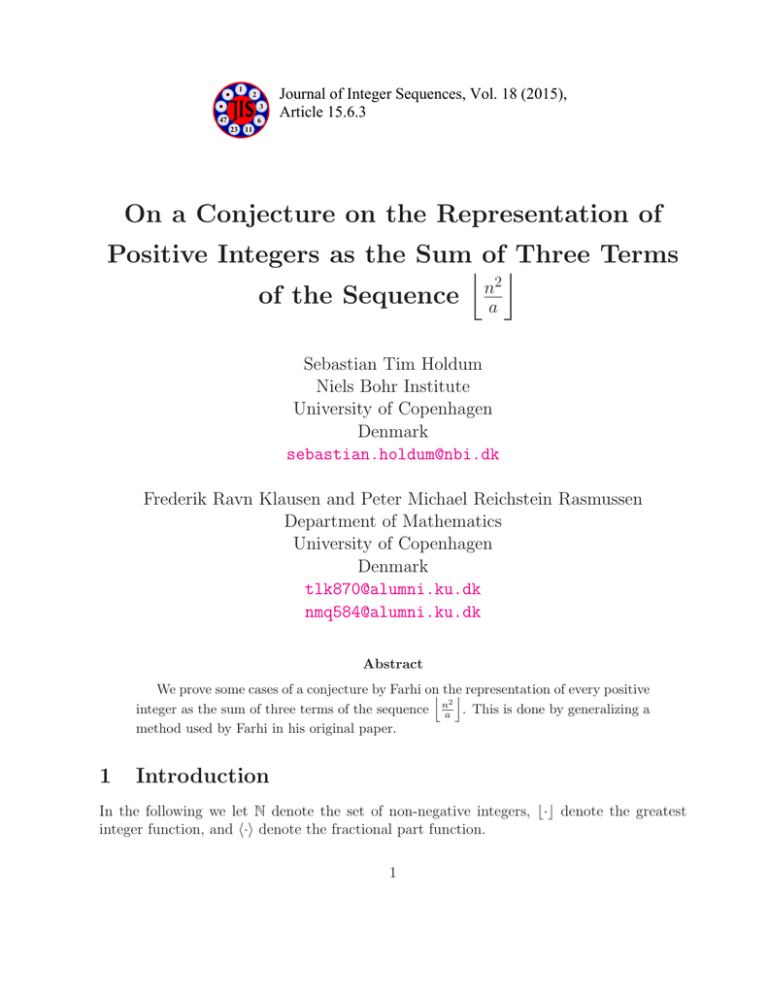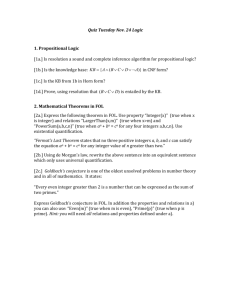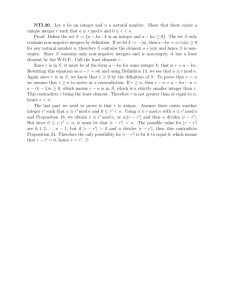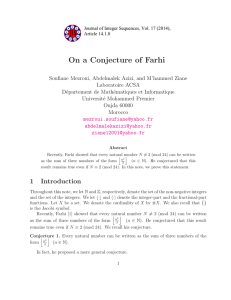On a Conjecture on the Representation of j k
advertisement

1
2
3
47
6
Journal of Integer Sequences, Vol. 18 (2015),
Article 15.6.3
23 11
On a Conjecture on the Representation of
Positive Integers as the SumjofkThree Terms
2
of the Sequence na
Sebastian Tim Holdum
Niels Bohr Institute
University of Copenhagen
Denmark
sebastian.holdum@nbi.dk
Frederik Ravn Klausen and Peter Michael Reichstein Rasmussen
Department of Mathematics
University of Copenhagen
Denmark
tlk870@alumni.ku.dk
nmq584@alumni.ku.dk
Abstract
We prove some cases of a conjecture by Farhi onj thek representation of every positive
2
integer as the sum of three terms of the sequence na . This is done by generalizing a
method used by Farhi in his original paper.
1
Introduction
In the following we let N denote the set of non-negative integers, ⌊·⌋ denote the greatest
integer function, and h·i denote the fractional part function.
1
A classical result by Legendre [3] states that every natural number not of the form
4s (8t + 7), s, t ∈ N can be written as the sum of three squares.
In relation to this, Farhi recently conjectured the following:
Conjecture 1 (Farhi [2]). Let a ≥ 3 be an integer. j
Then
kevery natural number can be
n2
represented as the sum of three terms of the sequence
.
a
n∈N
The conjecture was confirmed by Farhi [1] and Mezroui, Azizi, and Ziane [4] for a ∈
{3, 4, 8}.
In this paper we generalize the method used by Farhi for a = 4, and partially for a = 3,
to prove that the conjecture holds for a ∈ {4, 7, 8, 9, 20, 24, 40, 104, 120}. The method uses
Legendre’s three-square theorem and properties of quadratic residues.
We also note that the set of integers a such that Conjecture 1 holds is closed under
multiplication by a square.
2
Method and results
We start by introducing the following sets:
Definition 2. For any nonzero a ∈ N we define
Qa = {0 < ϕ < a | ∃x ∈ Z : ϕ ≡ x2
(mod a)}.
Therefore, Qa is the set of quadratic residues modulo a.
Definition 3. For any nonzero a ∈ N we define
Aa = {ϕ ∈ N | ∃x, y, z ∈ Qa ∪ {0} : ϕ = x + y + z}.
Thus, Aa is the set of integers that can be written as the sum of three elements of Qa ∪ {0}.
Definition 4. For any nonzero a ∈ N we define
Ra = {ϕ ∈ Aa | ∀ψ ∈ Aa : ϕ ≡ ψ
(mod a) ⇒ ϕ = ψ}.
So, Ra is the set of integers that can be written as the sum of three elements of Qa ∪ {0},
and such that no other integer in the same residue class modulo a has this property.
Now we are ready to formulate the main result.
Theorem 5. Let a ∈ N be nonzero and assume that for every k ∈ N there exists an r ∈ Ra
such that ak + r 6= 4s (8t + 7) for
ks, t ∈ N. Then every N ∈ N can be written as the sum
jany
n2
.
of three terms of the sequence
a
n∈N
2
Proof. Let N ∈ N be fixed. By assumption we can choose r ∈ Ra such that aN + r 6=
4s (8t + 7) for any s, t ∈ N. By Legendre’s theorem it follows that aN + r can be written of
the form
aN + r = A2 + B 2 + C 2
(1)
for some A, B, C ∈ N. Now we have
r ≡ A2 + B 2 + C 2
(mod a),
so
r = (A2 mod a) + (B 2 mod a) + (C 2 mod a),
(2)
since r ∈ Ra . Dividing by a and separating the integer and fractional parts of the right hand
side in (1), we get
2 2 2 2 2 2
A
B
C
A
B
C
r
+
+
+
+
+
,
N+ =
a
a
a
a
a
a
a
and from (2) we have
r
=
a
A2
a
+
B2
a
+
C2
a
,
so
2 2
A2
B
C
N=
+
+
.
a
a
a
Since we can find the sets Ra by computation, we can now apply the main theorem to
get the following corollary.
Corollary 6. Conjecture 1 is satisfied for a ∈ {4, 7, 8, 9, 20, 24, 40, 104, 120}.
Proof. Consider the following table:
a
4
7
8
9
20
24
40
104
120
Ra
{0, 1, 2, 3}
{4, 6}
{2, 3, 5, 6}
{1, 4, 7, 8}
{11, 15, 18, 19}
{11, 14, 19, 21, 22}
{27, 38}
{99}
{107}
3
Calculating modulo 8 it can be checked fairly easily that for each a ∈ {4, 7, 8, 9, 20, 24,
40, 104, 120} and every k ∈ N there exists an r ∈ Ra such that ak + r is not of the form
4s (8t + 7), s, t ∈ j
N, and
k thus every natural number can be written as the sum of three terms
n2
.
of the sequence
a
n∈N
To demonstrate this, we show the case a = 7. All the other cases are done in exactly the
same way.
For k ≡ 1, 2, 3, 6 or 7 (mod 8) we have 7k + 4 ≡ 3, 2, 1, 6 and 5 (mod 8), respectively,
and for k ≡ 0, 4 or 5 (mod 8) we have 7k + 6 ≡ 6, 2 and 1 (mod 8), respectively. Since
4s (8t + 7) ≡ 0, 4 or 7 (mod 8), s, t ∈ N, we conclude that for every k ∈ N we can write
7k + r, for r ∈ R7 = {4, 6}, such that it is not of the form 4s (8t + 7), s, t ∈ N. The case now
follows from Theorem 5.
Further, one should note that the set of integers satisfying Conjecture 1 is closed under
multiplication by a square.
Observation 7. Let M be the set of integers satisfying Conjecture 1. If a ∈ M, then
ak 2 ∈ M for any integer k > 0.
Proof. This follows easily since for any n we can find A, B, C ∈ N such that
2 2 2
B
C
A
+
+
n=
a
a
a
2
2
(Ak)
(Bk)
(Ck)2
=
+
+
.
ak 2
ak 2
ak 2
Knowing this, we see that since Conjecture 1 is satisfied for a = 3, 9, 4, and 8, it must
also hold for a = 3k for any positive integer k and for a = 2k , k > 1.
Finally, using Observation 7, Corollary 6, and the fact [4] that Conjecture 1 holds for
a = 3, we get that the conjecture holds for the following values up to 120.
a ∈ {3, 4, 7, 8, 9, 12, 16, 20, 24, 27, 28, 32, 36, 40, 48,
63, 64, 72, 75, 80, 81, 96, 100, 104, 108, 112, 120}.
Unfortunately, it seems that the method deployed in Theorem 5 is not extendable to other
cases, since its success relies on Ra , and in general Ra does not contain the necessary elements
for the condition in the theorem to be satisfied.
3
Acknowledgment
The authors would like to thank Jan Agentoft Nielsen for his suggestions that helped to
improve the manuscript.
4
References
[1] B. Farhi, jOn kthe representation of the natural numbers as the sum of three terms of the
2
sequence na , J. Integer Seq., 16 (2013), Article 13.6.4.
[2] B. Farhi, An elementary proof
j 2 kthat any natural number can be written as the sum of
three terms of the sequence n3 , J. Integer Seq., 17 (2014), Article 14.7.6.
[3] A. M. Legendre, Théorie des Nombres, 3rd ed., Vol. 2, 1830.
[4] S. Mezroui, A. Azizi, and M. Ziane, On a conjecture of Farhi, J. Integer Seq., 17 (2014),
Article 14.1.8.
2010 Mathematics Subject Classification: Primary 11B13.
Keywords: additive base, Legendre’s theorem.
Received September 29 2014; revised version received March 5 2015; May 19 2015. Published
in Journal of Integer Sequences, May 31 2015.
Return to Journal of Integer Sequences home page.
5





